Tales of ballplayers & Ian aftermath
BY GLENN MILLER
Roy Hobbs Baseball
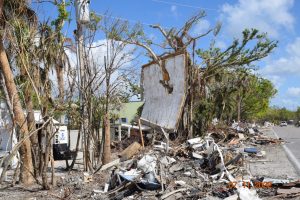
Anthony Aracri hunkered in his Sanibel home with a Kimber 9 sidearm, an AR-15 and many bottles of bourbon.
Anthony Montella, a retired New York City firefighter who worked on 9-11 and lost friends that horrible day, watched from his waterfront home at the mouth the Caloosahatchee as Hurricane Ian stomped inland. He was there with his wife, Erin, and feared that at one point they might have to march upstairs to their 7-year-old daughter’s room if the storm surge breached their home.
Veteran Roy Hobbs player Joe Paine found himself on the roof of his Fort Myers Beach home holding on to his 75-pound mixed breed dog named Dexter as 150 mile per hour winds howled and howled.
Lee Cosentino and his wife, Rebecca, and 9-year-old daughter, Rylinn, left their home near the Lee County Sports Complex for a friend’s Estero home farther east and south, away from the shoreline and storm surge. They fared well but Cosentino has visited devastated Sanibel dozens of times.
It’s been two months since Hurricane Ian roared ashore into Lee County, killing dozens, destroying homes and businesses. A footnote to the tragedy was the cancellation of the 2022 Roy Hobbs World Series.
Roy Hobbs players from distant states followed developments and worried about friends in Southwest Florida. They read about and viewed photos and video of the devastation wrought by the meteorological monster.
Ian was a storm of historic proportions when it steamed ashore over Cayo Costa, a barrier island just off the Lee County coast. Ian’s 150 mph winds made it the fifth strongest hurricane on record to hit the U.S., according to the National Oceanic and Atmospheric Administration website.
The agency pegged the storm surge on the beach at 12-to-18 feet and in the city of Fort Myers at a record 7.26 feet.
Steve Bertles and Chris Curtis reside near Dayton, Ohio, safe and far away. They were inspired to help, to pitch in with the recovery. So they drove 18-plus hours straight-through to pitch in to the recovery. They donated time and labored along with other volunteers from Samaritan’s Purse, a Christian charity, in a record November heat wave to help the region recovery.
Joe Breton and his wife, Helen, followed developments from their home in Hondo, Texas. They knew they needed to help so drove 1,550 miles in their 2000 Honda Accord to pitch in to recovery efforts, also with Samaritan’s Purse.
Every player has a story.
Inside Pitch reached out to a few and share them here. Longer teammates stories of these players are planned for the 2023 Roy Hobbs World Series program.
For now, here a few stories:
Send Guns, Bourbon & Boats
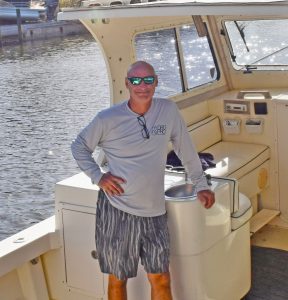
Anthony Aracri sat in the second floor living room of his Sanibel home watching the canal behind his home rise 2 feet in 30 minutes. That was around noon on Sept. 28, when the most powerful hurricane in recorded history to hit Lee County thundered overhead.
The wind screamed at Category 4 strengths verging on Category 5. The wind speeds rattled his 3-story home where he and his wife, Melanie, and 17-year-old son A.J. hunkered down. His two grown daughters, Analiese and Alayna, were not there.
The eye did not pass over Aracri’s house. The family was in the eyewall and remained in the eyewall as the storm lumbered north and east, lingering for hours over their community. Aracri, 52, estimates they felt the full fury for about 10 hours. The house shook. A big plate glass window breathed in and out.
“I said please don’t break because if it broke it would have lifted the roof up,” Aracri said a few weeks later, sitting on that same couch with that Kimber 9 sidearm tucked into the waistband of his shorts.
The sound was relentless.
“Howling, howling – whoosh! – howling,” Aracri said on a quiet and sunny day weeks after Ian left.
At one point during the storm, Aracri stepped outside.
“The wind hit me and blew me back 4 feet,” Aracri said.
Aracri didn’t evacuate ahead of the storm. Sanibel is his home. It’s where he has two businesses, HydroPro and Egret Pools. He coaches youth sports on the island.
The Miami native has resided on the island for 15 years. He felt safe despite the wind and rain and storm surge.
If the water reached the second floor, he planned to go to the third. If the water reached the third floor?
“If it gets that high, we’re f——-,” Aracri said.
In the weeks following the hurricane while the Sanibel Causeway was out, Aracri ferried residents from the mainland to the island and back in his “MLB” boat. The embarkation point on the mainland was a dock behind his friend and fellow Roy Hobbs player Anthony Montella’s home.
“MLB” does not stand for Major League Baseball. The boat is named in honor of his wife and the letters stand for Melanie’s Lobster Boat.
Ararcri is also a bourbon connoisseur. He has bottles of premium bourbon brands such as Pappy Van Winkle, WhistlePig and Blanton’s in his kitchen. He calls them his go-to drinks. They helped get him through Ian and its aftermath,
“I had a lot of bourbon,” Aracri said.
That’s not all.
“I will say bourbon and chocolate are excellent together,” Aracri said.
Help from the Buckeyes
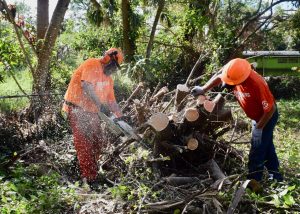
Instead of spending almost 2 weeks in Fort Myers playing together for the Wright City Reds or Dayton Wolves and hanging out with teammates and friends on Fort Myers Beach, Steve Bertles and Chris Curtis spent the time helping out.
Instead of swinging bats and catching and throwing balls, they used a chainsaw and grit and muscle to help clean up a devastated community.
On a steamy morning feeling more like September than early November, they labored In the backyard of a home nestled between the condo towers of downtown Fort Myers to the west and I-75 to the east. It was the 10th house they visited in a week of volunteering.
“Fort Myers has been very good to us over the years,” Bertles said.
Now, they were paying Fort Myers back.
Bertles and Curtis took a trip to Fort Myers Beach, where they often stayed and dined and reveled in serene sunsets in previous years. They have fond memories of spending part of their Roy Hobbs World Series near the north end of the beach around Times Square, a pocket of shops and restaurants and bars that thousands of Roy Hobbs players have likely visited over decades.
As Bertles said, that was a place they would “hang out.”
Not in 2022.
Instead, “This was our baseball week,” Bertles said. “We were going to be playing in the 45s & 53s. We kept the vacation and came down and volunteered.”
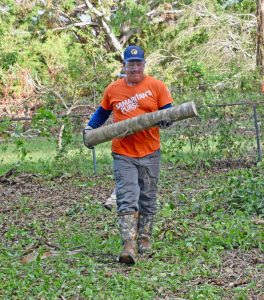
From the Home of the Hondo Hurricane
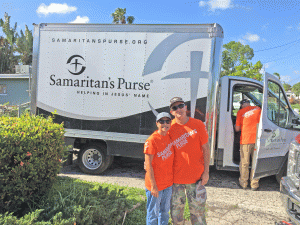
Hondo, Texas is well in-land and away from the Gulf of Mexico and the full fury of hurricanes. It’s where Joe Breton of the San Antonio Texans and his wife, Helen, reside.
A long time ago there was a big-league ballplayer from Hondo named Clint Hartung. His nickname was the Hondo Hurricane.
These Hondo residents and members of the Roy Hobbs Baseball Family followed the news out of Fort Myers. They were compelled to help and drove four days in their 2000 Honda Accord to do so. Like Steve Bertles and Chris Curtis, the Bretons volunteer for faith-based Samaritan’s Purse.
Joe is an Air Force retiree who has played, he estimated, in six or seven Roy Hobbs World Series. He worked as a navigator and registered pharmacist while in the service.
The couple’s original plan for the 2022 Roy Hobbs World Series was to stay at Sanibel Arms, which faces the Gulf of Mexico. It was hammered by Ian. On Sept. 28, Joe and Helen followed the storm news out of Fort Myers.
“We said we don’t know if the tournament is going to be cancelled but we know we’re not going to be staying on Sanibel,” Joe said.
As the hurricane news zipped around the nation, the Bretons leaned that, as Joe put it, that Sanibel was flattened. They knew the Sanibel Causeway was ripped apart.
“It was heartbreaking,” Helen said.
As soon as the 2002 Roy Hobbs World Series was canceled the Bretons knew they had to help the community they visit every fall. So they made the drive from deep in Texas and through southern parts of Louisiana, Mississippi, Alabama and east through the Florida Panhandle and on south to Fort Myers.
They came to work, not vacation. Their volunteering meant taking damaged furniture and appliances out of water-logged houses. It meant scraping mud from walls and floors and picking up debris in yards.
It was all done in steamy Florida weather. The storm damage was visible as they drove around in their Honda Accord. The piles of debris sometimes included family photos.
“These things can’t be replaced,” Helen said.
Joe said they’ve been told by storm victims they had they had been praying for help for weeks. They then told the Bretons that help “finally arrived.”
“They’re just so grateful and thankful,” Helen said, “You could tell just by looking at their faces.”
Riding Out the Storm with Dexter the Dog
Joe Paine is a Marine Corps veteran who graduated from boot camp at Parris Island in the 1970s. Maybe the crucible of that training and 4 years in the Corps prepared him for riding out a Category 4 hurricane on the roof of his 900-square foot Fort Myers Beach home.
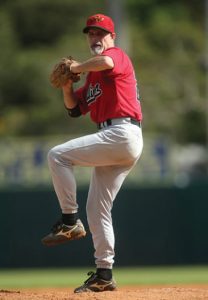
The house was destroyed. Many of the treasures Joe and Karen Paine had saved in more than 40 years of marriage were lost. Miraculously, the love letters they wrote one and another in the 1970s, back before email and Facebook and Twitter and when long-distance phone calls were too expensive were recovered.
But first, Karen worried about Joe. She had evacuated to a shelter on the mainland at South Fort Myers High, which is next to the Lee County Sports Complex. Joe stayed behind. As the storm surge inundated their neighborhood near the middle of the island, Joe sought refuge on the roof in the howling wind with Dexter, a large dog Karen described as “mixed whatever.”
Joe and Dexter endured 4 hours together on the roof as the water churned and the wind bellowed. That ordeal began around 2:30 p.m.
Karen described that time on the roof for her husband and dog as “the worst part of the storm.”
Joe declined to be interviewed for this account.
As Ian devastated Fort Myers Beach, much of the region lost power and Internet and cell service. Karen did not know what was happening to Joe, the father of their four grown children.
Their son and three daughters live up North. They didn’t know what was happening, either.
“I knew something really bad had happened,” Karen said.
So did the kids, who range in age from 27 to 35.
Karen feared the worse, that she had lost her husband, home and dog on the same day.
By 10 p.m. that night Karen learned Joe was alive.
They re-united the next day … and then drove 17 hours north, away from the devastation to family, to be with their kids and two grandkids.
From 9/11 to Hurricane Ian
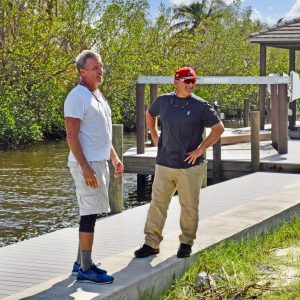
On Sept. 11, 2001, Anthony Montella was a New York City firefighter.
He was on vacation that day, driving away from New York City. As soon as he heard the news Montella turned around and returned to duty.
By time he arrived in Manhattan about 11 a.m., the Twin Towers were down.
“By then everybody was killed,” Montella said.
How many firefighters?
“343,” Montella said, sitting at a dining room table in his Fort Myers home, which survived Hurricane Ian intact.
Exactly 343 … That’s more than a number to Montella, a 15-year NYFD veteran. It’s been 21 years since that awful day but those who died that day were friends and compatriots.
Hurricane Ian lashed the Anthony Montella home on another September day.
The devastation and death toll of Ian is nowhere near that of 9/11.
Regardless, “I’ve been through a lot,” Montella, 57, said.
The Montella home is near the mouth of the Caloosahatchee, several miles south of where Ian made landfall.
He and Erin watched from their home and behind kevlar shutters as Ian roared up the river.
“I was definitely taken aback with the fury of Mother Nature,” Montella said, “I was watching 6-to-8-foot waves come off the Caloosahatchee.”
During the storm and in the weeks since, Montella hasn’t thought much about baseball.
In the wake of Ian, the Montella neighbors pitched in, helped one another. It was the same on Sanibel with Aracri and his neighbors.
“It was a Sept. 12 moment,” Montella said. “You know what I mean by that?”
On 9/12, America came together. On Sept. 29, Lee County and the Roy Hobbs Baseball family came together.
Another World, Another Time
From driving his blue Chevy Silverado out to Sanibel after often visiting the island by boat, Lee Cosentino knows what the place was like in the wake of Hurricane Ian.
“The first week out here was like the Wild West,” he said.
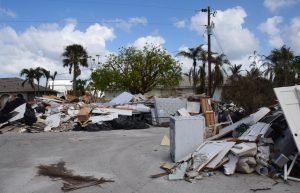
As a licensed contractor and owner of Bay to Beach Home Services, this veteran Roy Hobbs player originally from Chicago had regular access to the island.
He and his workers labored to clean up homes and condos. He witnessed the devastation up close and knows more than most what a herculean effort it took and is still taking to remove tons upon tons of debris.
Weeks after the Sept. 28 event, the sides of roads were still clogged with piles of mattresses, branches and other flotsam and jetsam that were not identifiable as anything other trash.
On a warm and calm day he drove Roy Hobbs owner Tom Giffen and me around the island. As he approached the Sanibel Causeway, Cosentino was asked to stop, zip down his window and show his ID.
The officer who asked was from the St. Petersburg Police Department. St. Pete is about 120 miles up Florida’s west coast and was spared the worst of the damage. In the wake of the storm, first responders from around the state and beyond swarmed into Lee County to help.
As he drove around, Cosentino stopped to check on a house belonging to a customer. He said a 4-foot gator had been found in the pool.
Mold was present in many homes after the storm.
“There are places that need to be completely gutted,” Cosentino said.
Cosentino, his wife and daughter reside in Brookshire, a community well in-land and near the Lee County Sports Complex. When it appeared Ian was headed for Englewood, south of Sarasota, friends drove south to stay with the Cosentinos … but, as Ian changed plans and headed toward Lee County, they moved farther east and south from the storm’s path to stay with friends in Estero.
Even there, in Estero, the winds howled. Cosentino estimates the winds there were more than 100 mph. A tornado was seen and heard nearby.
“It sounded like a freight train,” Cosentino said.
In the weeks since, Cosentino has been out to Sanibel every day, checking on the homes and condos of customers, working with his employees to fix what can be fixed and salvage what can be salvaged.
Of course, some places on the island and mainland the damage is too profound to do any fixing or salvaging. One of those places was a storage facility where Cosentino stored tools. He said it had four feet of water and he lost “personal items” and a kayak trailer.
Cosentino’s 9-year-old daughter, Rylinn, rode out the storm in Estero. A few weeks later and deep into recovery, he took Rylinn on a drive to see some of the damage.
“She was in shock,” Cosentino said.
Along with the rest of Southwest Florida.

